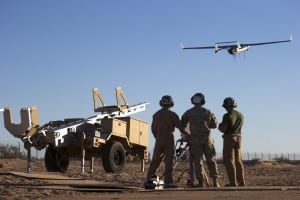The commandant of the Marine Corps this week said unmanned teaming and increased artificial intelligence (AI) is needed to maintain superiority over China in the future.
“I’m a believer in manned and unmanned teaming, I think that’s where we’re headed. But technologies are not going to replace the individual Marine, of course. It will enable the Marine to be more lethal,” Gen. David Berger said Tuesday during the National Defense Industrial Association’s 2021 Virtual Expeditionary Warfare Conference.

Berger highlighted a research project he recently saw that found a group of Marines trusted a robot it taught to accomplish a task more than one another group told it was preprogrammed for the same task.
“I would offer as in the same way that a squad leader has to trust his or her Marines, a squad leader is going to have to learn to trust their machine.”
However, Berger said in some instances currently the service does not trust these machines and while it has the ability for a faster targeting cycle they do not trust the process of AI.
“We have programs right now, capabilities right now that allow for fully automatic processing of sensor to shooter targeting, but we don’t trust the data. And we still ensure that there’s human intervention at every node. And, of course, with each intervention by humans we’re adding more time, more opportunities for mistakes to happen. Time we’re not going to have when an adversary’s targeting our network and any of those links of course are vulnerable.”
He said that Marines must trust the technology that they’re given to increase speed and is asking for technologies that help solve this trust issue.
Relatedly, Berger said adding unmanned systems is one of the Marine Corps’ top four pressing needs.
“We have got to move at an uncomfortable pace in unmanned systems,” he said.
While he called the CH-53K King Stallion helicopter “a phenomenal heavy lift aircraft,” later on the Marines will need a mix of that and an unmanned system to move equipment.
“Not all of it must be manned. In fact, it’s to our advantage if it’s not all manned.”
During the event, Berger was asked how he defines low-cost expendable unmanned vehicles that he argued are necessary in a Washington Post op-ed this week.
“I don’t know the answer, but we won’t find out that answer unless we drive in that direction…This is the value of experimentation,” Berger responded.
As opposed to the immediate post-Cold War era when the U.S. military could afford to only buy the most advanced systems, “we’re going to have to get comfortable with throwaway things.”
Berger clarified he does not think everything should be shifted to expendable unmanned systems, but “we should move in that direction to find out what the right balance is.”
For example, Berger said he thinks they will need manned helicopters to move some things “as far as I can see” but he has questions on what the balance is for the unmanned systems.
“But they all don’t have to be manned and could some of them be expendable after 100 runs? Where’s the cost break point for that? What kind of missions do we need the human in the cockpit and what kind of missions we don’t need them at all?”
“And if that thing is built to last right now, a helicopter, we’re going to hold on to it for 25, 30 years. But an expendable one, what if it’s done its business in a year and we buy another one, it’s unmanned? Can we do that? Where’s the knee in the curve that says that’s affordable,” Berger continued.

Berger also illustrated some unmanned system issues are more about moral and ethical points like when considering medical helicopters.
“If it’s faster to get an unmanned platform there and pick you up, are we ok with that? We’re headed in an area where we haven’t gone to before but if you can picture the tv show M*A*S*H, but there’s no pilot in there but you can get it there faster because there’s more of them – is that worth the trade? Might be. It could be.”
Berger said he does not know the dollar value at which unmanned systems are expendable or the ration of manned to unmanned systems.
“I believe we have to move aggressively in that direction, in order to discover those things, in order to learn those things.”
Separately, Berger emphasized he thinks the Marine Corps’ overall acquisition speed will have to be uncomfortable for the foreseeable future to counter China and Russia.
“I am convinced we’re going to go faster than we’re comfortable going for a long time.”
“I think the discomfort part right now is that we have a very capable adversary or two who are moving very quickly and using our technology to go actually faster than us. So we’re not going to be comfortable for a long time, in terms of requirement to acquisition to fielding,” he continued.
Berger said adversaries like China are harvesting capabilities the U.S. invests in, then “catapulting off of it.”
He said the military services need to do a better job of describing how they are using various acquisition authorities wisely and if there is an adequate and appropriate amount of oversight along the way.
“We have to openly communicate with Congress along the way, paired up with industry, to say here’s where we are, here’s where we’re going and it’s moving pretty fast. Our responsibility is to communicate that to Congress with the checks and balances, with the oversight to ensure if we’re going to use things like mid-tier acquisition authorities, that we’re using the proper things for the proper requirements and oversight is in place.”